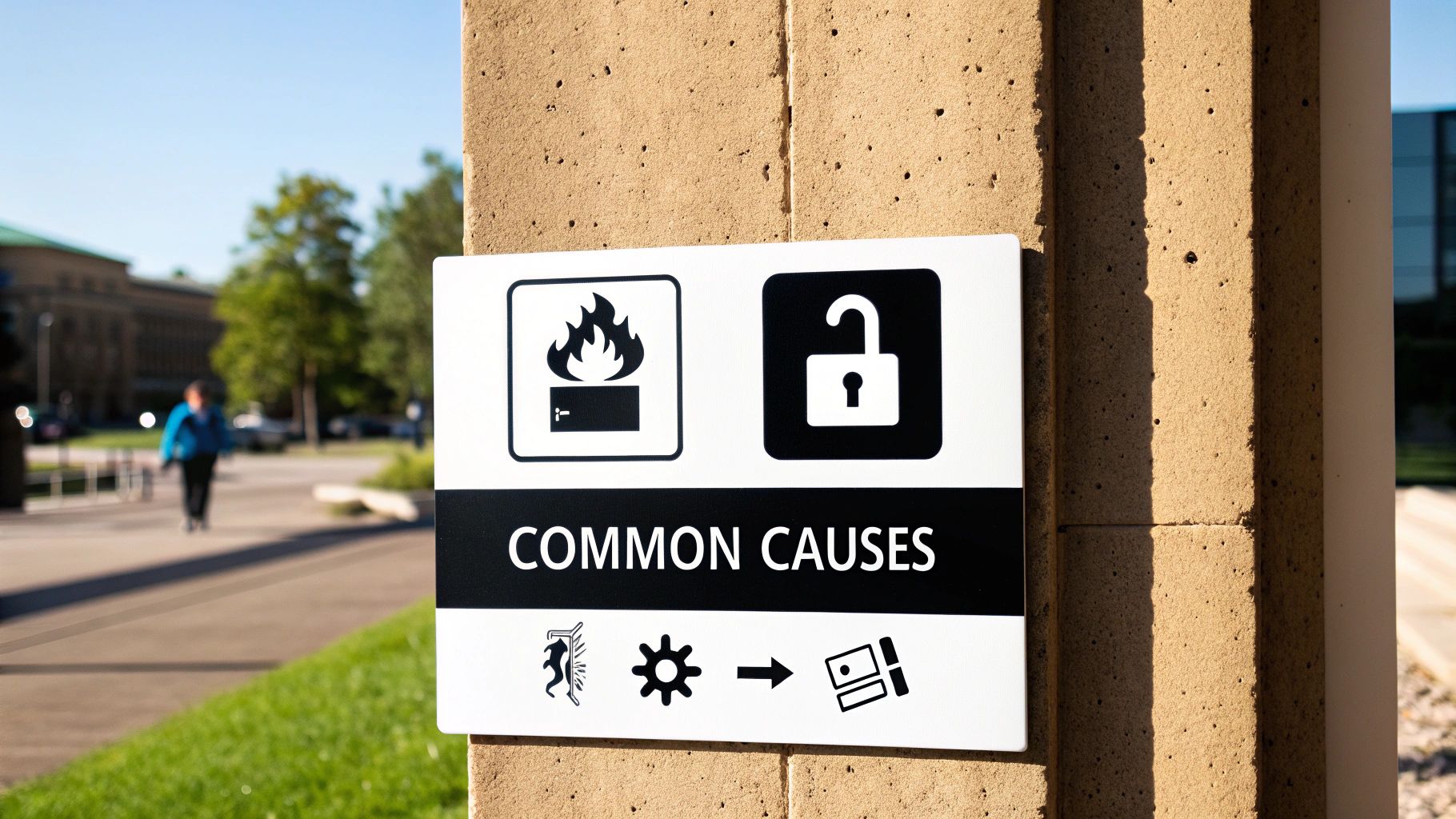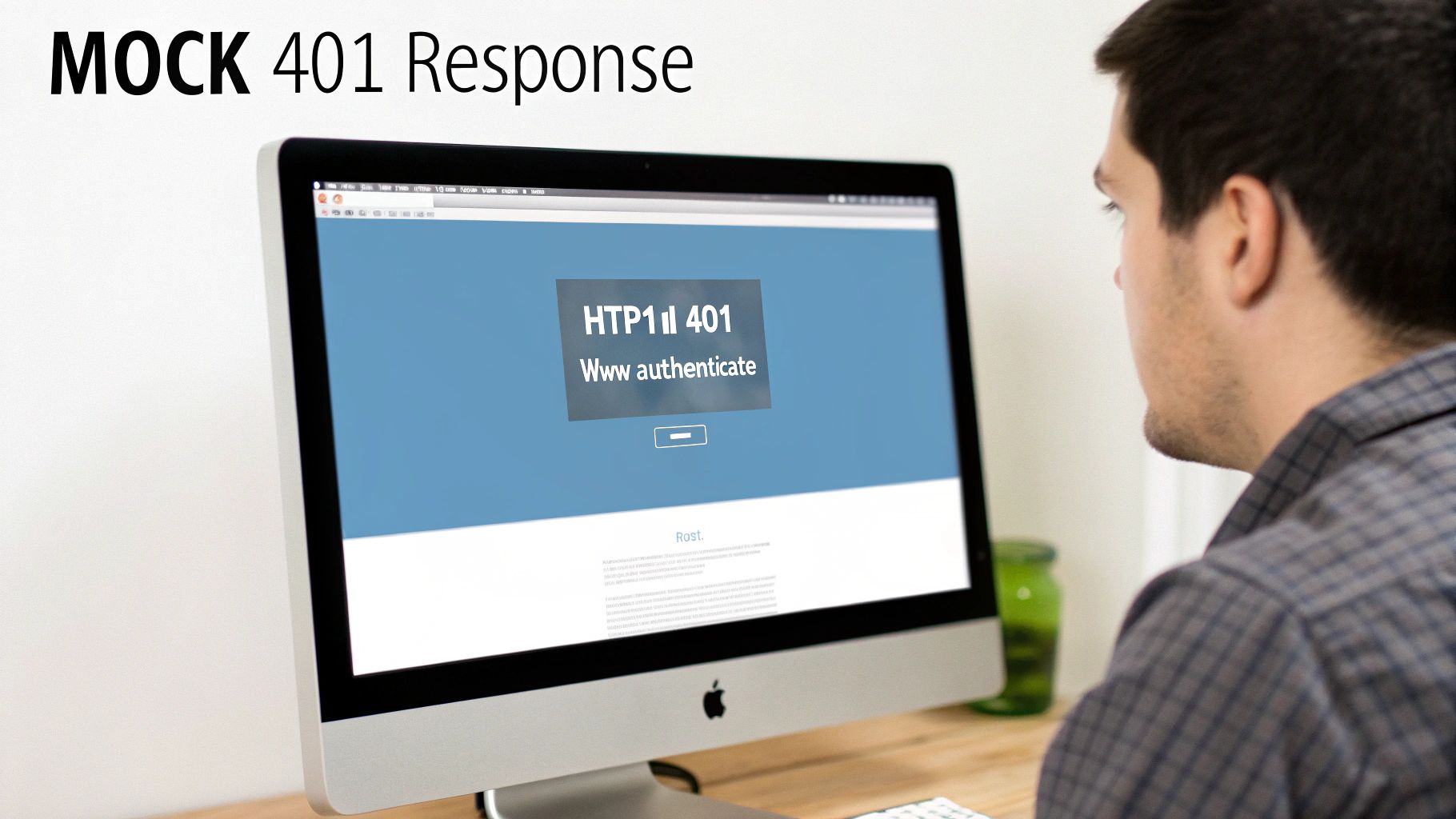Fixing the HTTP Error Code 401 Unauthorized
Ever seen an HTTP error code 401? It's often called the "Unauthorized" error, and it pops up when you try to access a web page without the right credentials. Think of it like a digital bouncer at a club door asking for an ID you haven't shown yet. The server sees you're there, but it won't let you in until you prove who you are.
What the 401 Unauthorized Error Really Means

Picture yourself showing up to a members-only event. The host at the door stops you—not because you're banned, but simply because they need to see your membership card or ticket. That’s the perfect analogy for a 401 error. It's just a temporary roadblock, a signal that something went wrong with the authentication process.
This error has been a cornerstone of web security since the early 1990s. Its whole purpose is to guard protected resources by demanding proper credentials before letting anyone through. For a deeper dive into the technical side, you can check out Abstract API's detailed guide on the topic.
Authentication vs. Authorization
It's easy to mix up a 401 error with its close cousin, the 403 Forbidden error. The difference comes down to two very distinct concepts:
Authentication (401 Error): This is all about proving your identity. The server has no idea who you are. A 401 happens when you try to log in with the wrong password or don't provide any credentials at all.
Authorization (403 Error): This is about having the right permissions. The server knows exactly who you are, but your account simply isn't allowed to access that specific resource. You're logged in, but you're not on the guest list.
To put it simply, a 401 is like being stopped for not having an ID, while a 403 is like having a valid ID but still not being on the VIP list.
The Role of the WWW-Authenticate Header
When a server sends back a 401 error, it doesn't just slam the door in your face. It also includes a helpful hint called the WWW-Authenticate header.
This header tells your browser exactly what kind of "ID" it needs to provide next time. It might specify a basic username and password combination or ask for a more modern security token. For any developer trying to fix the problem, understanding this header is always the first step.
Common Causes Behind the 401 Error

When a 401 error pops up, it’s the server's way of saying, "I can't let you in without the right key." It's a sign that something in the authentication process went wrong. While it might feel technical, the reasons are often surprisingly simple, ranging from a tiny user typo to a more complex issue on the server's end.
Think of it this way: a mistyped username or password is like fumbling with the wrong key at a locked door. It just won't fit. In the same vein, an expired session token is like a hotel keycard that has passed its checkout date—it worked yesterday, but today, the system has locked you out.
User-Side vs. Developer-Side Issues
The source of a 401 Unauthorized error almost always lands in one of two places: something wrong on the user's end (client-side) or a problem with the website's code (server-side). Knowing which camp the problem falls into is the key to fixing it fast.
A user can clear an outdated browser cache themselves, but a broken API token needs a developer to step in. Figuring out where the problem started is the first and most important step. For developers, this often means diving into the backend, a critical part of any good API security testing plan.
It's worth noting that 401 responses make up a huge chunk of all HTTP errors on secure websites. They’re often triggered by expired credentials, old browser data, or even website plugins that interfere with the authentication process.
A Quick Diagnostic Checklist
To help you get to the bottom of the issue, we've put together a quick checklist. Many 401 errors can be resolved in minutes once you know what to look for.
This table breaks down the most common culprits, who they usually affect, and the first thing you should try to fix the problem.
401 Error Cause and Solution Checklist
| Potential Cause | Who It Affects | Quick Fix |
|---|---|---|
| Incorrect Login Details | User | Double-check your username and password for typos. |
| Expired Session Token | User | Log out completely, then log back in to get a fresh session. |
| Outdated Browser Cache | User | Clear your browser's cache and cookies to get rid of old data. |
| Invalid API Token | Developer | Verify the token is correct, not expired, and has the right permissions. |
| Firewall Misconfiguration | Developer | Check firewall rules to make sure they aren't blocking authentication headers. |
By running through these common scenarios, you can quickly narrow down the possibilities and get back on track.
How to Fix the 401 Error as a Website User

Running into an HTTP error code 401 is definitely annoying, but the good news is you can usually fix it yourself in just a few minutes. Most of the time, the problem isn't some deep technical issue but a simple hiccup with your browser or a small data mismatch.
Before you start digging into settings, try the two quickest fixes. A simple page refresh (Ctrl+R or Cmd+R) can sometimes clear a temporary communication glitch. If that doesn’t do the trick, log out of the website completely and then log back in. This simple cycle forces the site to start a fresh, authenticated session, which often resolves the 401 error right away.
Check the Simple Stuff First
You’d be surprised how often the simplest explanation is the right one. A tiny typo is a common culprit behind a 401 error.
- Double-Check the URL: Look closely at the web address. It's easy to mistype something or click a bad link, accidentally sending you to a page you don't have permission to see.
- Verify Your Credentials: We've all done it. Carefully re-type your username and password, paying close attention to any case-sensitive characters or special symbols.
Clear Out Old Data
If the basics don't solve it, the next place to look is your browser's stored data. Sometimes, old or corrupted files can interfere with the authentication process.
Your browser holds onto bits of information in its cache and cookies to make websites load faster. But every now and then, this saved data can conflict with a new login attempt, causing the server to get confused and reject your credentials.
Clearing this out gives your browser a fresh start. In Google Chrome, head to Settings > Privacy and security > Clear browsing data. Just be sure to check the boxes for "Cookies and other site data" and "Cached images and files," then hit "Clear data." Restart your browser and try again—this one step fixes a huge number of user-side 401 issues.
As a final check, try opening the website in an Incognito or Private window. This mode loads the page without any of your saved cookies or extensions. If you can log in successfully here, it almost certainly means a browser extension is causing the problem. You'll just have to go back and disable your extensions one by one to find the one causing the conflict.
A Developer's Guide to Resolving 401 Errors
For a developer, an HTTP 401 Unauthorized error isn't just a dead end; it's a clue. It tells you something is wrong with the authentication handshake between the client and the server. Think of it as a bouncer at a club turning someone away—they either didn't show an ID, the ID was fake, or it was expired.
The usual suspect is the Authorization header. It’s surprisingly easy to forget to attach it, send an expired Bearer token, or just get the syntax wrong. Your first move should always be to pop open your browser's developer tools, find the network request, and check that header. Is it there? Is it formatted correctly?
Pinpointing Authentication Flaws
Sometimes the problem runs deeper than a simple header mistake. A flawed implementation of an OAuth 2.0 flow or a mismatched JWT (JSON Web Token) secret key on the server can cause authentication to fail for everyone.
Let's break down where things can go wrong:
- Token Management: Is your application correctly storing and, more importantly, refreshing tokens? An expired token is probably the most common reason you'll see a 401 error in the wild.
- Server Configuration: Take a look at your server-side middleware. A misconfigured authentication module in Express, Apache, or Nginx can mistakenly reject perfectly valid credentials before they even hit your main application logic.
- API Key Issues: If you're using API keys, double-check that they are active, have the right permissions, and are being sent in the header or query parameter the server is expecting.
A proactive approach is always your best bet. You can sidestep many 401 Unauthorized errors by integrating solid web application security best practices right from the start of your project.
Getting the authentication flow right is a non-negotiable part of building a secure app. For a deeper dive into protecting your endpoints, be sure to read our guide on building an API with authentication. These core principles will help you create a reliable system where legitimate users get in and unauthorized requests are stopped at the door.
How to Test and Simulate 401 Responses with dotMock

The best way to fix a problem is to see it coming. Instead of waiting for a live server to fail, you can intentionally create a controlled failure scenario. This is where API mocking tools like dotMock come in, giving you the power to simulate specific responses without needing a live backend.
Why Mocking 401 Errors Is a Smart Move
A great application isn't just about handling sunny-day scenarios; it’s about how gracefully it manages the storms. Proactively simulating an HTTP 401 error is a crucial step in building a polished and reliable user experience.
Think about it: what happens when a user's session token expires right as they're about to complete an important action? By mocking a 401 response, you can test your app's recovery logic. You can make sure it correctly redirects them to the login page with a helpful message, rather than leaving them at a confusing dead end. This kind of preparation is what separates a good app from a great one.
Simulating authentication failures is no longer a "nice-to-have"—it's a core practice for modern development teams. It allows you to validate error-handling pathways that keep users informed and engaged, even when things go wrong.
Setting Up a 401 Simulation
Creating a mock 401 response in dotMock is incredibly straightforward. You just define an endpoint that consistently returns a 401 Unauthorized status code. To make the simulation even more realistic, you can add a WWW-Authenticate header to the mock response, perfectly mimicking how a real-world server would behave.
This controlled environment gives you a sandbox to see exactly how your frontend reacts. You can verify that:
- The user is automatically logged out.
- A clear, user-friendly error message is displayed.
- The application correctly attempts to refresh an expired token.
Using dotMock to create these specific conditions helps you build a more resilient and professional application. To dive deeper, check out dotMock's powerful response rules and see how you can configure all sorts of endpoint behaviors to ensure your application handles authentication issues flawlessly every time.
Common Questions About the 401 Error
When you start digging into HTTP status codes, a few common questions always pop up. Let's clear up some of the most frequent ones about the 401 error.
What’s the Difference Between a 401 and 403 Error?
It all comes down to authentication versus authorization.
Think of a 401 Unauthorized error as a bouncer at a club asking for your ID. The server is saying, "I don't know who you are. Prove it." You haven't provided the right credentials (like a valid password or API key) to get in the door.
A 403 Forbidden error is different. In this case, the bouncer knows exactly who you are—you've shown your ID—but your name isn't on the list for the VIP section. The server has authenticated you, but you simply don't have the permission to access that specific resource.
Can a 401 Error Hurt My Website's SEO?
It certainly can, but it all depends on the context. If search engine bots are constantly running into 401 errors on pages that should be public, that's a problem. They can't access and index your content, which means your search rankings will suffer.
On the other hand, for pages that are meant to be private—like a user's account dashboard or a members-only section—a 401 is actually the correct response. It tells search engines, "Nothing to see here, move along," which is exactly what you want.
The WWW-Authenticate header is a crucial piece of the 401 response. It's the server's way of telling the browser exactly which authentication method, such as 'Basic' or 'Bearer', is required to gain access.
Ready to build more resilient applications by testing every possible scenario? With dotMock, you can simulate 401 errors and other critical responses in seconds, ensuring your app handles authentication failures gracefully. Start mocking for free today.